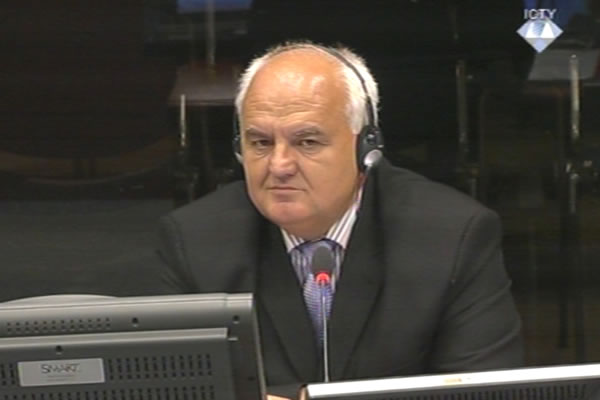Home
FORCED TO ‘DISARM PEOPLE FORCIBLY’
Karadzic’s military expert Dragomir Keserovic contends that the Serb authorities in Sanski Most were ‘forced to forcibly disarm’ non-Serbs. The witness denied that he had participated in the ‘mop-up operation’ in the Cerska valley. The general did admit that he was able to understand fully the Geneva Conventions in 2011, when he analyzed the topic in greater detail
 Dragomir Keserovic, defence witness of Radovan Karadzic
Dragomir Keserovic, defence witness of Radovan Karadzic After a two-week break, General Dragomir Keserovic returned to the witness stand in the case against the former Republika Srpska president Radovan Karadzic to answer the prosecutor’s questions about his findings whose purpose was to contest the conclusions reached by the prosecution military expert Ewan Brown.
Keserovic was examined in chief by the accused in early July 2013. He then claimed there was no systematic expulsion of the non-Serb population. Keserovic claimed that the crimes had been committed by ‘irresponsible individuals’ and that the 1st Krajina Corps did everything it could to prevent the crimes and punish the perpetrators. Prosecutor Julian Nichols brought up the killing of 80 civilians in the school in Velagici in Kljuc municipality as an example of a failure to punish perpetrators whose identity was known. Keserovic argued that ‘orders were issued to take measures’ to prosecute the culprits; the RS authorities always stressed the need to ‘protect the civilian population and respect the laws of war’. When Keserovic claimed that some persons were still serving lengthy prison sentences in Bosnia, the prosecutor noted that they were not prosecuted by the 1st Krajina Corps, as the witness claimed, but by the civil courts in Banja Luka.
Karadzic’s expert explained that only those who didn’t surrender to the Krajina Corps were attacked and ‘forcibly disarmed’ in Sanski Most. The prosecutor noted that the disarming of civilians who were armed only with hunting rifles was carried out by artillery attacks. Keserovic replied that the Serb forces were ‘forced to forcibly disarm’ those people because of daily attacks on the army and the police. According to him, the destruction ‘was not intentional': it was the consequence of ‘the failure to obey the authorities in an area’.
The prosecutor then showed the witness a document dated 4 June 1992 which states that ‘politicians, extremists and undesirables in the territory of the Sanski Most municipality’ were deported to the Manjaca prison camp. The detainees thus did not include any fighters or war criminals. Keserovic explained that he considered ‘all those who could be accorded the status of prisoners of war under the international conventions’ and who took part in combat in some capacity as prisoners. According to the documents shown to the witness by the prosecutor, 2,000 civilians were interned there. The military expert claims that in 1992 he didn’t know that civilians could not be accorded the status of prisoners of war; he realized that in 2011 when he studied the topic in greater detail.
At the end of Keserovic’s evidence, the prosecutor told the witness that Ratko Mladic’s order indicates he had commanded the units that had participated in the mop-up operation in the Cerska valley. As alleged in the indictment, sometime between 13 and 17 July 1995, about 150 persons were killed along the road in the Cerska valley. Keserovic claims that he received an oral order relieving him of his duty and was given a new assignment. The prosecutor put it to him that he had to say something along those lines in order to clear himself of the blame for the executions. Keserovic tersely replied, ‘I don’t have to say anything, because that’s how it was’.
In the re-examination, Karadzic suggested that in Mahala in Sanski Most the VRS artillery targeted the paramilitary units, not civilians.Linked Reports
- Case : Karadzic
- 2013-07-24 PROSECUTION: WRONG CONCLUSIONS BASED ON SELECTIVE SOURCES
- 2013-07-23 KARADZIC’S EXPERT PREPARED TO ACCEPT JUST 500 SREBRENICA VICTIMS
- 2013-07-22 WITNESS WITH ‘CLEAR CONSCIENCE’ AND PROBLEMATIC PAST
- 2013-07-29 MENDELJEV DJURIC’S ‘CATEGORICAL DENIALS’
- 2013-07-30 FORMER POLICEMAN’S LAW CAREER
- 2013-07-31 BROTHERS IN ARMS
